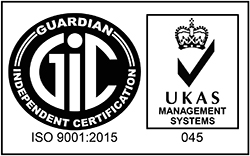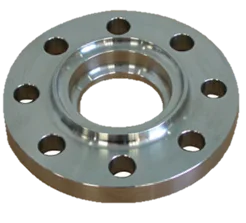
Socket weld flange is normally available with a raised face, a flat face, or an RTJ facing. When a raised face is required for socket weld flanges, the standard height for socket weld flanges under 400# is 1/16”. And the standard socket weld flange raised face height for 400# and higher socket weld pipe flanges is 1/4″.
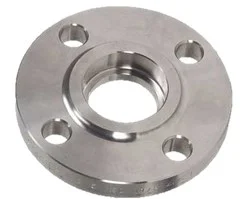
What is a Socket Weld Flange?
Socket weld flange is commonly found on smaller diameter high pressure pipes. Inserting the pipe into the socket end and applying fillet weld around the top is how these pipe flanges are attached. This results in a smooth bore and improved flow of the fluid or gas inside the pipe. Furthermore, put on pipe flanges with hubs have published specifications ranging from 1/2” to 24”. Also, socket weld flange is available in a variety of material grades, specifications, and sizes.
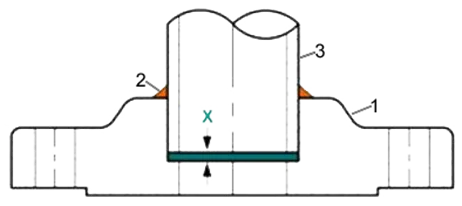
Usage of Socket Weld Pipe
Pull back 1.6mm (1/16″) of the inserted pipe, put the pipe end into the socket weld flange until the pipe bottom touches the shoulder area, and then perform fillet welding. The goal is to weld a fillet to separate the flange from the pipes or fittings, leaving an expansion gap.
Features of Socket Weld Flange
A good fit of the pipe is made possible by the recess on the inside diameter of the socket weld flange, allowing for a smooth flow of liquid.
For smaller diameters and greater pressure/temperature settings, socket welding flanges are effective.
They are comparable to slip-on flanges, but they also have to state the schedule of the pipe they will be used with.
How Socket Weld Flange is Produced?
In order to prevent cracking faults brought on by thermal pressures during heating processes, the socket welding flange was initially employed for stainless steel superheaters. However, after years of development, it has become a regular application for all sorts of materials.
Types of Socket Welded Flange
Socket welded flanges, such as the raised face type and ring type joint type, are similar to other welding flange types (slip on, weld neck or blind flange).
Raised Face Type
A tiny piece of the RF Type RF socket weld flange projects from the face and surrounds the flange bore. This raised portion will house the gasket seat.
Ring Type Joint Type
There is an RTJ style groove on the raised face surface that you may fit a gasket ring in to improve sealing abilities.
Advantages of Socket Welded Flange
- To reduce the possibility of leaking, socket weld flanges could take the place of threaded flanges.
- Before welding, there is no need to bevel.
- Outside of the pipe, welding work cannot enter the pipe bore.
- Applications where interior welding operations are extremely challenging are advised to use it. Internal pockets are removed to the sock welding process. It is to prevent heat warpage and weld spatter damage to the flange face.
- It has a longer fatigue life and the same internal pressure as sliding on the flange.
Disadvantages of Socket Welded Flange
- Socket welding needs more advanced welding abilities since the increasing space between the pipe and shoulder must be maintained at 1/16 inch during welding.
- For anti-corrosive pipes like stainless steel pipes, the expansion gap increases the likelihood of crack flaws, therefore cracks between the pipe and flange will result in corrosive issues.
- Socket Weld flange cannot be used in corrosive or radioactive environments. It is because of the risk of operating and maintenance issues associated with solid build-up at the junction. Hence, welding is used more frequently. It makes connections stronger and less susceptible to corrosion when it is done entirely through the pipe from the outside to the inside.
The Differences Between Socket Weld Flange & Slip On Flange
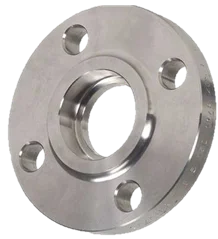

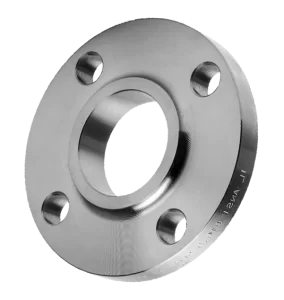
Socket weld flange is similar in shape to a slip-on flange; however, a socket-welded flange differs in having a shoulder at the inner bore.
Also, there is no shoulder at the inner bore for a slip-on flange.
Other than that, the static strength of a socket weld flange is the same as that of a slip-on flange, but its fatigue strength is 50% greater than that of a double-welded slip-on flange.
Product Tags
Type | Blind Flange, Slip on Flange, Welding Neck Flange, Socket Weld Flange, Threaded Flange, Lap Joint Flange, Anchor Flange, Orifice Flange |
Size Range | 1/2" (15mm) - 48" (1200mm) |
Class | 150#, 300#, 600#, 900#, 1500#, 2500# |
Type Available | Raised Face RF, Ring Type Joint RTJ, Flat Face FF, Male & Female M&F, Tongue Groove T&G |
Schedule | SCH 10, SCH 20, SCH 30, SCH 40, SCH 60, SCH 80, SCH 100, SCH 120, SCH 140, SCH 160 SCH STD, SCH XS, SCH XXS SCH 10s, SCH 40s, SCH 80s |
Standard | ASME B16.1, ASME B16.5, ASME B16.20, ASME B16.21, ASME B16.24, ASME B16.34, ASME B16.36, ASME B16.42, ASME B16.47 MSS SP-6, MSS SP-9, MSS SP-25, MSS SP-44, MSS SP-53, MSS SP-54, MSS SP-55, MSS SP-75, MSS SP-106 API 605, API 6A, API 6B |
Specification | |
Carbon Steel | ASME/ASTM SA/A105N |
High Yield Carbon Steel | ASTM A694 F42/ 46/ 52/ 60/ 65/ 70 ASTM A707 L1~ L8 |
Low Temp Carbon Steel | ASME/ASTM SA/A350 LF1/ 2/ 3/ 6 |
Chrome Moly | ASME/ASTM SA/A182F2, F5 ,F9, F11, F12, F22, F91 |
Stainless Steel | ASME/ASTM SA/A182F304/304L, 316/316L, 309, 310, 304H, 310H, 317/317L, 321, 321H, 347, 347H, 904L |
Duplex/ Super Duplex | UNS S31803, S32205, S32750, S32760 |
Nickel Alloy | ASME/ASTM SB564, |
Remark | HIC, PED 2014/68/EU, NACE MR0175, NORSOK, Weld Overlay available |
flanges supplier malaysia
Looking for flanges, fittings, pipes, valves and gasket?
Saliran Group has over 10 years of experiences in trading of a wide range of flanges, pipes, valves, fittings, gasket and related parts and accessories (“PVF products”) as well as steel products with numerous happy customers all around the world. We supply a variety of gaskets either in metal, non-metal as well as food-grade approval available material.
Click on the link below to contact us now!

